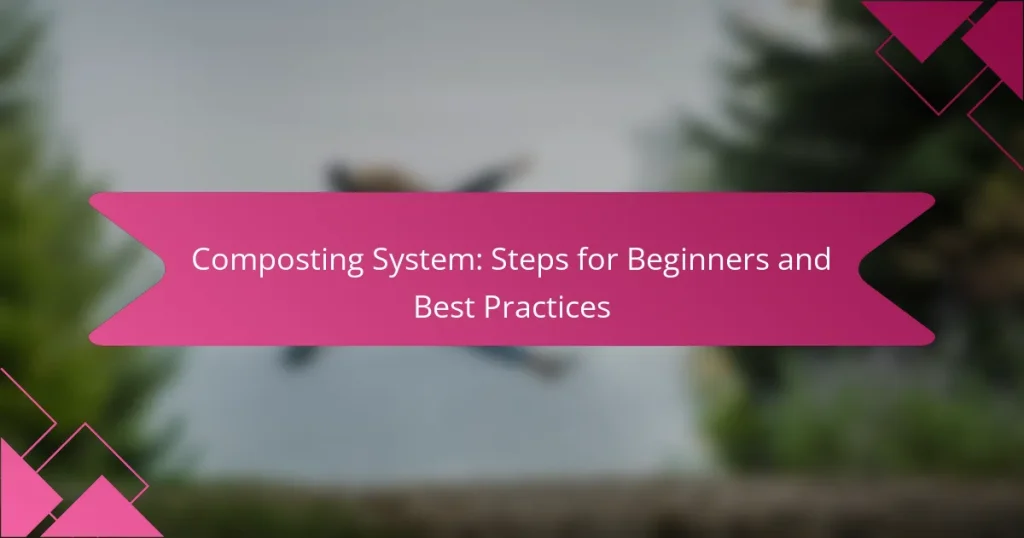Composting is an eco-friendly way to recycle organic waste, turning it into nutrient-rich compost for your garden. For beginners, various systems like bin, tumbler, and worm composting offer tailored solutions based on space and commitment. By selecting the right method and understanding the materials to include, you can effectively reduce landfill waste while enriching your soil.
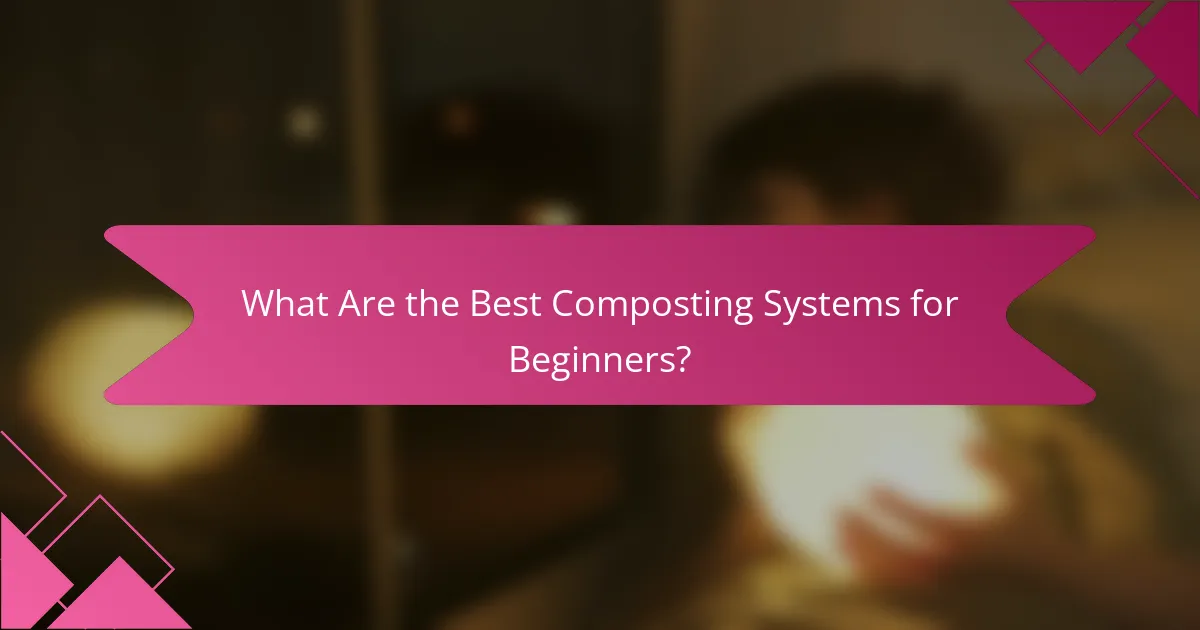
What Are the Best Composting Systems for Beginners?
For beginners, the best composting systems include bin composting, tumbler composting, pile composting, worm composting, and indoor composting. Each method has unique features that cater to different spaces, materials, and levels of involvement.
Bin composting
Bin composting involves using a designated container to hold organic waste, which helps contain odors and pests. These bins can be made from wood, plastic, or metal, and are often available in various sizes to fit your yard or garden space.
To start, layer green materials like fruit scraps and grass clippings with brown materials such as dried leaves and cardboard. Turn the compost every few weeks to aerate it, which speeds up the decomposition process.
Tumbler composting
Tumbler composting uses a rotating drum to mix compost materials, making it easier to aerate and speed up decomposition. This method is ideal for those who want a more hands-off approach and quicker results.
Fill the tumbler with a balanced mix of greens and browns, then turn it every few days. Most tumblers have a capacity of around 50 to 100 liters, making them suitable for small to medium households.
Pile composting
Pile composting is the simplest method, where organic waste is stacked in a designated area. This method requires minimal investment and is suitable for larger quantities of waste.
To create a successful compost pile, ensure a good mix of materials and turn the pile regularly to maintain aeration. A pile should ideally be at least one cubic meter to retain heat and promote effective decomposition.
Worm composting
Worm composting, or vermicomposting, utilizes red worms to break down kitchen scraps into nutrient-rich compost. This method is perfect for those with limited outdoor space and can be done indoors or on a balcony.
Set up a worm bin with bedding materials like shredded newspaper and add food scraps. Keep the bin moist but not soggy, and ensure proper ventilation. Harvest the worm castings every few months for use in your garden.
Indoor composting
Indoor composting allows you to recycle kitchen waste without needing outdoor space. This can be achieved through methods like bokashi fermentation or small compost bins designed for indoor use.
For bokashi, layer food waste with bokashi bran in a sealed container to ferment the waste. After a few weeks, bury the fermented waste in soil or add it to a traditional compost bin. Indoor compost bins typically use a carbon filter to minimize odors.
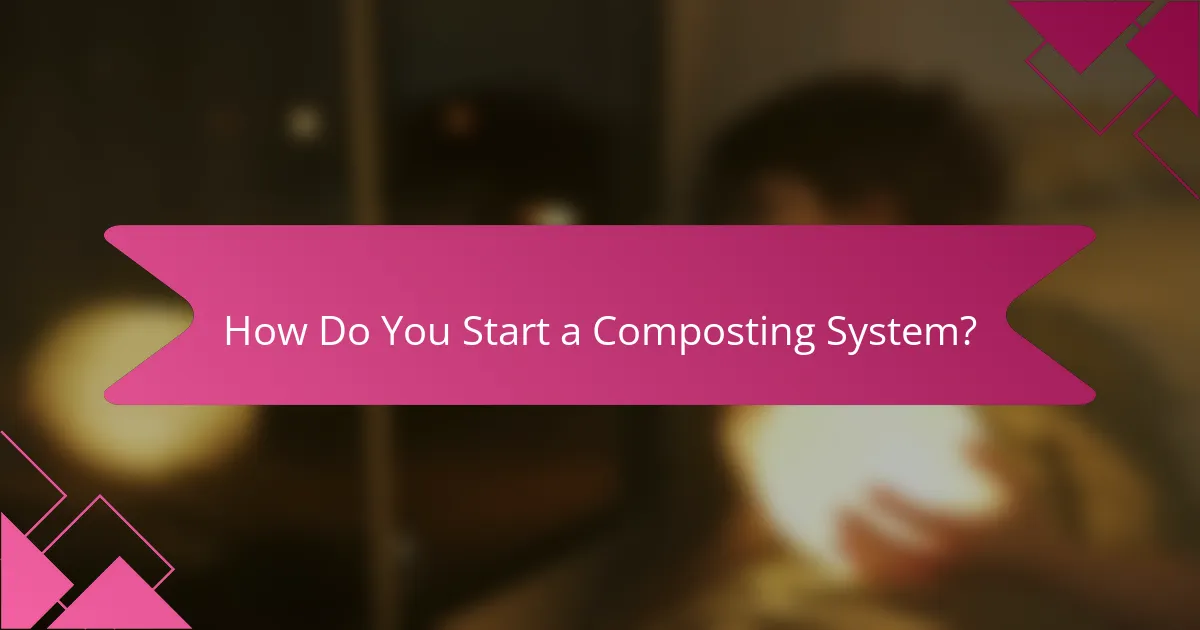
How Do You Start a Composting System?
Starting a composting system involves selecting a method, gathering suitable materials, and setting up a designated area for composting. This process transforms organic waste into nutrient-rich compost, benefiting your garden and reducing landfill waste.
Choose a composting method
There are several composting methods to consider, including traditional compost bins, tumblers, and vermicomposting with worms. Each method has its own advantages; for instance, tumblers can speed up the process, while vermicomposting is great for small spaces.
Evaluate your available space, the amount of waste you generate, and how quickly you want compost. For beginners, a simple bin or pile may be the easiest way to start, while more advanced methods can yield faster results.
Gather compostable materials
Collecting the right compostable materials is crucial for a successful composting system. Common compostables include fruit and vegetable scraps, coffee grounds, eggshells, grass clippings, and dried leaves.
Avoid adding meat, dairy, and oily foods, as these can attract pests and create odors. Aim for a balanced mix of green materials (nitrogen-rich) and brown materials (carbon-rich) to promote effective decomposition.
Set up your composting area
Designate a suitable area for your composting system, ideally in a dry, shady spot that is easily accessible. If using a bin, ensure it has good airflow and drainage to facilitate the composting process.
For a pile, start with a base of coarse materials like twigs to enhance aeration. Layer your compostable materials, alternating between greens and browns, and turn the pile regularly to speed up decomposition and maintain airflow.

What Materials Can You Compost?
You can compost a variety of organic materials, which can be broadly categorized into green and brown materials. Understanding what to include and what to avoid is essential for creating a healthy compost system that enriches your soil.
Green materials
Green materials are rich in nitrogen and include items like vegetable scraps, grass clippings, and coffee grounds. These materials are typically moist and help to speed up the composting process by providing essential nutrients.
When adding green materials, aim for a balance of about one part green to two parts brown materials. This ratio helps maintain the right moisture levels and promotes effective decomposition.
Brown materials
Brown materials are high in carbon and include dried leaves, straw, and cardboard. These materials are essential for aeration and help to absorb excess moisture in the compost pile.
To optimize your compost, include a variety of brown materials to create a diverse mix. Shredding larger items can help them break down more quickly, enhancing the overall composting process.
Avoidable materials
Certain materials should be avoided in composting, such as meat, dairy, and oily foods, as they can attract pests and create odors. Additionally, avoid composting diseased plants and weeds that may spread seeds.
Other items to steer clear of include glossy paper, treated wood, and pet waste, as they may introduce harmful chemicals or pathogens into your compost. Always check local guidelines for specific regulations regarding composting materials.

What Are the Key Steps in Composting?
The key steps in composting involve layering organic materials, maintaining proper moisture levels, and regularly turning the compost. These practices ensure that the composting process is efficient and results in nutrient-rich soil amendment.
Layering materials
Layering materials is crucial for creating a balanced compost pile. Start with a base of coarse materials like straw or small branches to promote airflow, followed by layers of green materials such as kitchen scraps and grass clippings, and then brown materials like dried leaves or cardboard. Aim for a ratio of about 2 parts brown to 1 part green to optimize decomposition.
When adding materials, chop or shred larger items to speed up the breakdown process. Avoid adding meat, dairy, and oily foods, as these can attract pests and create odors.
Maintaining moisture
Maintaining moisture in your compost pile is essential for microbial activity. The compost should feel like a damp sponge; if it’s too dry, decomposition slows down, and if it’s too wet, it can become anaerobic and smell bad. Regularly check the moisture level and add water or dry materials as needed.
In dry climates, consider covering the compost pile with a tarp to retain moisture, while in wet conditions, ensure good drainage to prevent waterlogging.
Turning the compost
Turning the compost helps aerate the pile and speeds up the decomposition process. Aim to turn your compost every few weeks, using a pitchfork or shovel to mix the materials and introduce oxygen. This process also helps to evenly distribute moisture and heat throughout the pile.
When turning, check the temperature; a hot compost pile (around 130°F to 160°F) indicates active decomposition. If the pile cools down, it may need more green materials or moisture to reactivate the process.
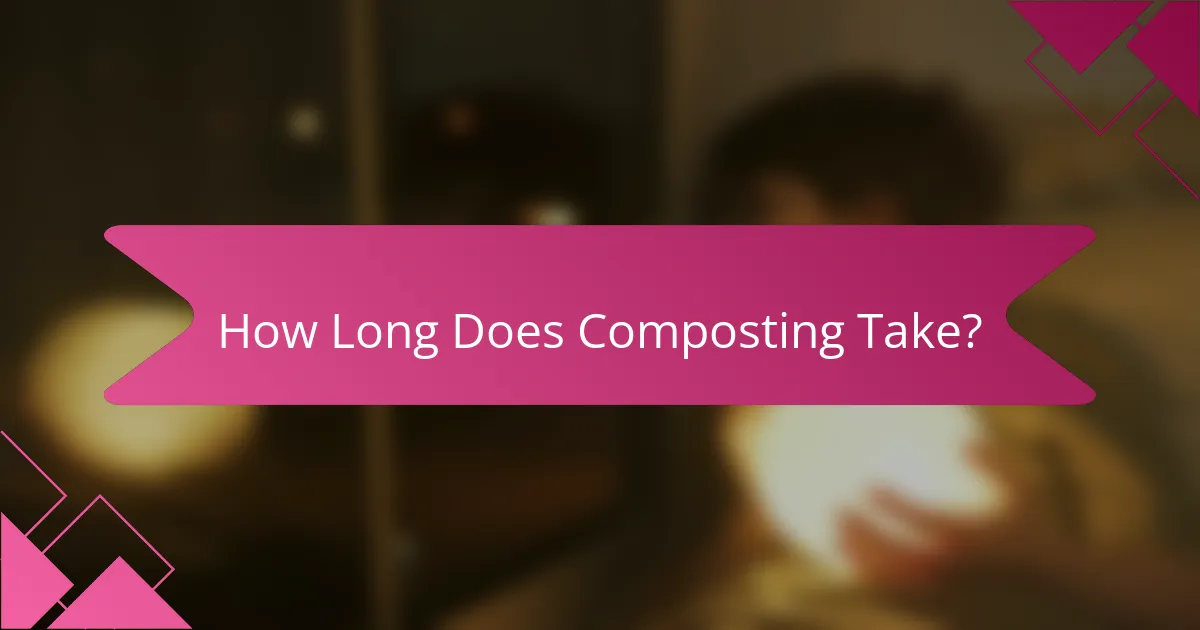
How Long Does Composting Take?
Composting can take anywhere from a few weeks to several months, depending on various factors. The process involves breaking down organic material into nutrient-rich compost, and the duration is influenced by conditions such as temperature, moisture, and the materials used.
Factors affecting composting time
Several key factors can significantly impact how long composting takes. Temperature plays a crucial role; warmer conditions generally speed up decomposition. The moisture level is also important, as compost needs to be damp but not soggy to facilitate microbial activity.
The type of materials you use can affect the timeline as well. For instance, smaller, shredded pieces of organic waste break down faster than larger chunks. A balanced mix of green materials (like fruit scraps) and brown materials (like dried leaves) can enhance the composting process.
Typical composting timelines
In ideal conditions, a hot composting system can produce finished compost in about 4 to 6 weeks. However, a cold composting method may take anywhere from 6 months to a year to fully decompose. Understanding these timelines can help you plan your gardening activities more effectively.
To optimize your composting process, consider turning your pile every few weeks to aerate it. This can help maintain higher temperatures and speed up decomposition. Regularly checking moisture levels and adjusting as needed will also contribute to a more efficient composting timeline.
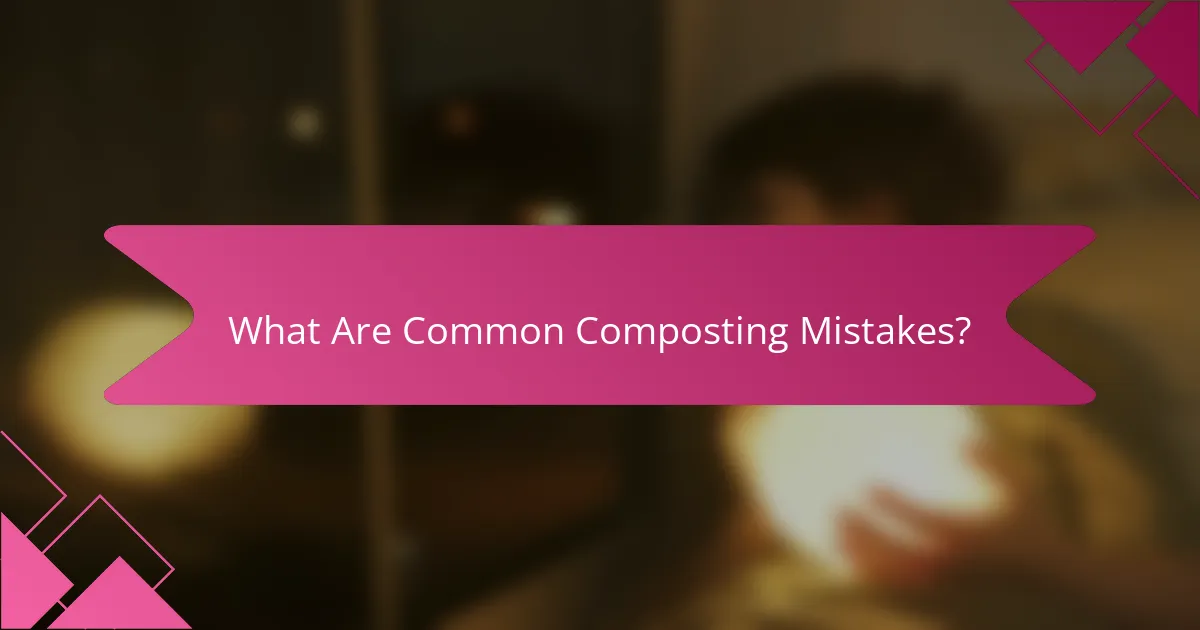
What Are Common Composting Mistakes?
Common composting mistakes can hinder the effectiveness of your compost pile and lead to unpleasant odors or slow decomposition. Understanding these pitfalls is crucial for beginners aiming to create rich, healthy compost.
Overloading with greens
Overloading your compost with greens, or nitrogen-rich materials, can create an imbalance that leads to a smelly, anaerobic pile. While greens like kitchen scraps and fresh grass clippings are essential for composting, they should be balanced with browns, or carbon-rich materials.
A good rule of thumb is to maintain a ratio of about 2:1 or 3:1 of browns to greens. This helps ensure proper aeration and decomposition. If your compost smells or is slimy, it may be a sign that you need to add more browns, such as dried leaves, straw, or shredded paper.
To avoid this mistake, regularly monitor your compost pile and adjust the materials as needed. Incorporating a variety of both greens and browns will enhance the microbial activity and speed up the composting process.
